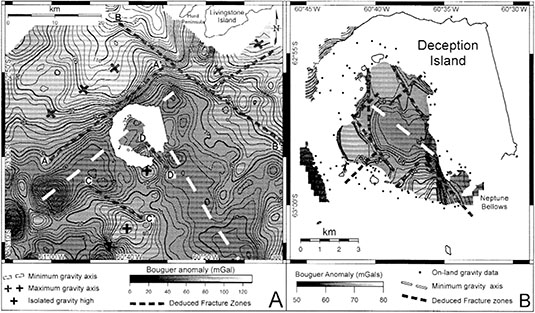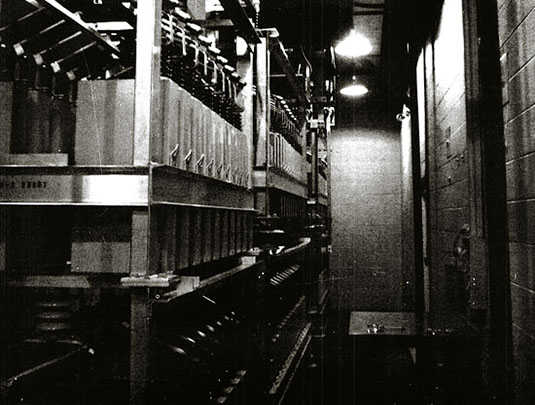 [Image: Deception Island, from Millett G. Morgan’s September 1960 paper An Island as a Natural Very-Low-Frequency Transmitting Antenna].
[Image: Deception Island, from Millett G. Morgan’s September 1960 paper An Island as a Natural Very-Low-Frequency Transmitting Antenna].
Yesterday’s post reminded me of an interesting proposal from the 1960s, in which an entire Antarctic island would be transformed into a radio-conducting antenna. Signals of international (or military submarine) origin could thus be bounced, relayed, captured, and re-transmitted using the topographical features of the island itself, and naturally occurring ionospheric radio noise could be studied.
 [Image: A map of Deception Island, taken from an otherwise unrelated paper called “Upper crustal structure of Deception Island area (Bransfield Strait, Antarctica) from gravity and magnetic modelling,” published in Antarctic Science (2005)].
[Image: A map of Deception Island, taken from an otherwise unrelated paper called “Upper crustal structure of Deception Island area (Bransfield Strait, Antarctica) from gravity and magnetic modelling,” published in Antarctic Science (2005)].
In the September 1960 issue of IEEE Transactions on Antennas and Propagation, radio theorist Millett G. Morgan, a “leading researcher in the field of ionospheric physics” based at Dartmouth, speculated that he could generate artificial “whistlers”—that is, audial electromagnetic effects that are usually caused by lightning—if only he could find the right island.
“In thinking about how to generate whistlers artificially,” Morgan’s proposal leisurely begins, “it has occurred to me that an island of suitable size and shape, extending through the conducting sea, may constitute a naturally resonant, VLF slot antenna of high quality.”
 [Image: Deception Island, from “Upper crustal structure of Deception Island area (Bransfield Strait, Antarctica) from gravity and magnetic modelling,” Antarctic Science (2005)].
[Image: Deception Island, from “Upper crustal structure of Deception Island area (Bransfield Strait, Antarctica) from gravity and magnetic modelling,” Antarctic Science (2005)].
He looked far and wide for this “naturally resonant, VLF slot antenna,” eventually settling on a remote island in the Antarctic. “Following this line of reasoning,” he explains, “I thought first of the annular Pacific atolls, but knowing of the fresh-water lenses in them”—that is, aquatic features that would destructively interfere with radio transmissions—”[I] rejected them as being too pervious to water to be satisfactory insulators. Also, of course, they are not found in suitable latitudes for generating whistlers.”
Morgan’s reasoning continued: “The Pacific atolls are built upon submerged volcanic cones and this led me to think of Deception Island in the SubAntarctic, a remarkable, similarly shaped, volcanic island in which the volcanic rock extends above the surface; and which is located in the South Shetland Islands where the rate of occurrence of natural whistlers has been found to be very great.”
Perhaps the island could be the geologic radio antenna he was looking for.
 [Image: Deception Island, from “Upper crustal structure of Deception Island area (Bransfield Strait, Antarctica) from gravity and magnetic modelling,” Antarctic Science (2005)].
[Image: Deception Island, from “Upper crustal structure of Deception Island area (Bransfield Strait, Antarctica) from gravity and magnetic modelling,” Antarctic Science (2005)].
Morgan points out in detail that mathematical ratios amongst the island’s naturally occurring landscape features, including its ring-shaped lagoon, are perfect for supporting radio transmissions (even the relationship between the length of the island and the radio wavelengths Morgan would be using seems to work out). And that’s before he looks at the material construction of the island itself, consisting of volcanic tuff, which would help the terrain act as an “insulator.”
There is even the fact that the island’s small lagoon is coincidentally but unrelatedly named “Telefon Bay” (alas, named after a ship called the Telefon, not for the island’s natural ability to make telephone calls).
 [Image: Deception Island, from “Upper crustal structure of Deception Island area (Bransfield Strait, Antarctica) from gravity and magnetic modelling,” Antarctic Science (2005)].
[Image: Deception Island, from “Upper crustal structure of Deception Island area (Bransfield Strait, Antarctica) from gravity and magnetic modelling,” Antarctic Science (2005)].
Morgan’s “proposed island antenna” would thus be a wired-up matrix of transmission lines and natural landscape features, bouncing radio wavelengths at the perfect angle from one side to the other and concentrating broadcasts for human use and listening.
You could tune into the sky, huddling in the Antarctic cold and listening to the curling electromagnetic crackle of the ionosphere, or you could use your new radio-architectural set-up, all wires and insulators like some strange astronomical harp, “to generate whistlers artificially,” as Morgan’s initial speculation stated, bursting forth with planetary-scale arcs of noise over a frozen sea, a wizard of sound alone and self-deafened at the bottom of the world.
(Deception Island proposal discovered via Douglas Kahn, whose forthcoming book Arts of the Spectrum: In the nature of electromagnetism looks fantastic, and who also gave an interesting talk on “natural radio” a few years ago at UCLA).
 [Image: From “Probing Cosmic-Ray Transport with Radio Synchrotron Harps in the Galactic Center,” by Timon Thomas, Christoph Pfrommer, and Torsten Enßlin.]
[Image: From “Probing Cosmic-Ray Transport with Radio Synchrotron Harps in the Galactic Center,” by Timon Thomas, Christoph Pfrommer, and Torsten Enßlin.] [Image: Via
[Image: Via  [Image: [Image: Deception Island, from Millett G. Morgan’s September 1960 paper An Island as a Natural Very-Low-Frequency Transmitting Antenna].
[Image: [Image: Deception Island, from Millett G. Morgan’s September 1960 paper An Island as a Natural Very-Low-Frequency Transmitting Antenna]. [Image:
[Image: 

 [Image: One of the stations of Project ELF, via
[Image: One of the stations of Project ELF, via  [Image: From Roy Johnson, “Project Sanguine,” originally published in The Wisconsin Engineer (November 1969)].
[Image: From Roy Johnson, “Project Sanguine,” originally published in The Wisconsin Engineer (November 1969)]. [Image: Inside Project Sanguine; photo from Roy Johnson, The Wisconsin Engineer (November 1969)].
[Image: Inside Project Sanguine; photo from Roy Johnson, The Wisconsin Engineer (November 1969)].
 [Image: Deception Island, from Millett G. Morgan’s September 1960 paper An Island as a Natural Very-Low-Frequency Transmitting Antenna].
[Image: Deception Island, from Millett G. Morgan’s September 1960 paper An Island as a Natural Very-Low-Frequency Transmitting Antenna]. [Image: A map of Deception Island, taken from an otherwise unrelated paper called “Upper crustal structure of Deception Island area (Bransfield Strait, Antarctica) from gravity and magnetic modelling,” published in Antarctic Science (2005)].
[Image: A map of Deception Island, taken from an otherwise unrelated paper called “Upper crustal structure of Deception Island area (Bransfield Strait, Antarctica) from gravity and magnetic modelling,” published in Antarctic Science (2005)]. [Image: Deception Island, from “Upper crustal structure of Deception Island area (Bransfield Strait, Antarctica) from gravity and magnetic modelling,” Antarctic Science (2005)].
[Image: Deception Island, from “Upper crustal structure of Deception Island area (Bransfield Strait, Antarctica) from gravity and magnetic modelling,” Antarctic Science (2005)]. [Image: Deception Island, from “Upper crustal structure of Deception Island area (Bransfield Strait, Antarctica) from gravity and magnetic modelling,” Antarctic Science (2005)].
[Image: Deception Island, from “Upper crustal structure of Deception Island area (Bransfield Strait, Antarctica) from gravity and magnetic modelling,” Antarctic Science (2005)]. [Image: Deception Island, from “Upper crustal structure of Deception Island area (Bransfield Strait, Antarctica) from gravity and magnetic modelling,” Antarctic Science (2005)].
[Image: Deception Island, from “Upper crustal structure of Deception Island area (Bransfield Strait, Antarctica) from gravity and magnetic modelling,” Antarctic Science (2005)].
 [Image: A mountainous display of women closely choreographed with water by Busby Berkeley, via Alexander Trevi’s
[Image: A mountainous display of women closely choreographed with water by Busby Berkeley, via Alexander Trevi’s